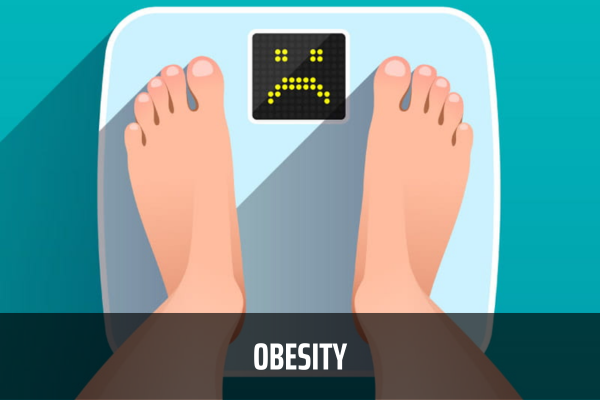How to recognize obesity? What are causes of obesity as diagnosed by the Ministry of Health of Vietnam?
Ministry of Health of Vietnam: How much weight is obesity? How to recognize obesity?
Pursuant to the Guidelines for Diagnosis and Treatment of Obesity issued with Decision 2892/QD-BYT in 2022, there are instructions on how to recognize obesity as follows:
The Guidelines specify the methods to recognize obesity as follows:
(1) Body Mass Index (BMI)
Standing Height: Measured using a measuring tape. The person being measured stands upright in a comfortable position, looking straight ahead, with the feet together forming a V shape. Measure a straight line from the top of the head to the feet. The result is calculated in meters with an accuracy of no more than 0.1 cm.
Body Weight: The person being measured wears lightweight clothing, removes shoes, and stands on the scale in the correct position. The weight is displayed on the screen. Measure the body weight accurately to 0.1 kg. The unit of weight is represented in kilograms (kg).
BMI (kg/m2) = Body Weight (kg) / Height (m) * Height (m)
Example: Body Weight: 58 kg, Height: 1.58 m
The BMI is calculated as follows: 58 / (1.58 * 1.58) = 23.2 => overweight
Assessment of overweight and obesity status is based on the WHO standards applied to Asian individuals.
BMI (kg/m2) | Classification |
< 18,5 | Underweight |
18,5 - 22,9 | Normal |
23-24,9 | Overweight |
25 - 29,9 | Class 1 obesity |
≥ 30 | Class 2 obesity |
(2) Waist circumference
The tool used is a measuring tape with markings produced in Vietnam that meets the standards of the Vietnam Metrology Department.
Measurement method: The patient stands with both feet together, 10 cm apart, evenly distributing body weight on both feet, exposing the measurement area. The patient breathes steadily, measuring when exhaling lightly, avoiding muscle contraction.
Waist circumference: Measured horizontally at the midpoint between the top of the pelvic bone and the bottom of the last rib bone. The margin of error is no more than 0.1 cm. The result is calculated in centimeters (cm).
Evaluation: Obesity in males (upper body obesity, abdominal obesity, apple-shaped obesity, central obesity) is defined as a waist circumference ≥ 90 cm in males and ≥ 80 cm in females (according to the Ministry of Health and the Vietnam Association of Endocrinology & Diabetes).
(3) Dual-energy X-ray absorptiometry (DEXA)
Dual-energy X-ray absorptiometry is considered the "gold standard" for assessing body fat mass. DEXA has been widely used to study bone demineralization and osteoporosis and has shown significant progress in assessing body fat mass due to its ease of use in clinical settings and higher accuracy in distinguishing lean tissue and fat compared to previous methods such as whole-body underwater weighing (hydrodensitometry).
DEXA defines a technology in which the reduction of radiation at two energy levels is used to determine two components of the reduced tissue, either bone and soft tissue or lean tissue and fat. Many experts consider DEXA as one of the "gold standards" for assessing body fat.
Valuable studies have shown that DEXA's assessment of body fat mass generally correlates well with the four-compartment model, where body fat mass is estimated from body density measurements such as underwater weighing (hydrodensitometry), total body water content (typically measured by diluted deuterium), and bone mineral density values obtained from DEXA.
However, studies have shown that DEXA may underestimate body fat mass in individuals with low body fat percentage and overestimate body fat mass in individuals with higher body fat percentage, both in adults and children.
Recently, DEXA has been used to assess the distribution of fat in specific body regions. Abdominal fat is often measured between the L1 and L4 vertebrae on DEXA images. Research has shown that abdominal fat mass measured by DEXA and CT have a high correlation, although DEXA systematically underestimates the quantifiable abdominal fat mass measured by CT. However, DEXA cannot differentiate subcutaneous fat from visceral fat.
DEXA's assessment of body fat requires very low radiation exposure (1 μSv), allowing for appropriate repeated measurements in clinical settings. The DEXA measurement process is also quick and easy, suitable for both healthy individuals and patients. Assessing body fat mass with DEXA requires specialized equipment with reasonable costs, making it easily accessible in an obesity clinic.
DEXA is a suitable tool for measuring body fat composition and distribution, but it is currently primarily reserved for research purposes until more data on risk prediction and cost-effectiveness are available.

How to recognize obesity? What are causes of obesity as diagnosed by the Ministry of Health of Vietnam?
What are causes of obesity as diagnosed by the Ministry of Health of Vietnam?
Pursuant to the Guidelines for the Diagnosis and Treatment of Obesity issued with Decision 2892/QD-BYT in 2022, the following causes of obesity are mentioned:
(1) Nutritional causes:
- The nutritional causes of obesity are diverse and mainly include:
- Excessive energy intake: Consuming more energy than the body needs.
Overeating can be caused by various factors such as:
+ Family habits
+ Subjective choices to eat more
- High-fat diet
- In children: Consuming excessive sugary foods increases the risk of obesity
- Breastfeeding for less than 3 months is often associated with an increased risk of obesity in children when they start school.
(2) Genetic causes:
- Adipose cells can easily divide in one of two ways:
- Hyperplasia: both the volume and number of adipose cells increase (3-4 times), occurring in children or during puberty, and is difficult to treat.
- Hypertrophy: adipose cells enlarge due to increased fat accumulation, but the number of cells does not increase, commonly found in adults and has a better prognosis.
(3) Endocrine causes:
- Hypothalamic damage due to trauma, malignant diseases, infections, hypogonadism, decreased gonadotropin production.
- Obesity-hypogonadism syndrome
- Hypothyroidism
Cushing's syndrome
- Insulin-secreting pancreatic tumors
- Polycystic ovary syndrome
(4) Pathological causes:
- Excessive production of adipose cells without an increase in cell size.
- Hypertrophy of adipose cells without an increase in cell number, which only occurs when the adipose cells are fully enlarged.
(5) Medication-related causes:
- Steroid hormones
- Classic antidepressants (tricyclic, tetracyclic, MAOIs)
- Benzodiazepines
- Lithium
- Antipsychotic medications
(6) Other causes:
- Sedentary lifestyle, lack of physical activity
- Smoking cessation. Active weight management is necessary when quitting smoking.
- Smoking during pregnancy: Children of mothers who smoke during pregnancy have an increased risk of significant weight gain in the future.
However, obese patients may have multiple combined causes.
Ministry of Health of Vietnam: What are types of obesity?
Pursuant to the Guidelines for the Diagnosis and Treatment of Obesity issued with Decision 2892/QD-BYT in 2022, the different types of obesity are described as follows:
Male-pattern obesity (upper body obesity, abdominal obesity, apple-shaped obesity, central obesity):
- Fat distribution is prominent in the abdomen, trunk, shoulders, arms, neck, and face. The face appears flushed.
- Muscle development differs from Cushing's syndrome.
- This type of obesity is often seen in individuals who overeat.
Male-pattern obesity is more prone to metabolic complications such as metabolic syndrome, prediabetes, type 2 diabetes, gout, cardiovascular diseases, hypertension, gallbladder diseases, breast cancer, etc.
Female-pattern obesity (lower body obesity, pear-shaped obesity):
- Fat distribution is mainly in the lower part of the body (pelvic area, waistline, buttocks, thighs).
- The skin appears bluish.
- There is less muscle development.
- Often accompanied by weakness.
- Often associated with venous insufficiency and menstrual disorders in females.
Mixed obesity:
Fat distribution is relatively even throughout the body. Severe obesity cases are often classified as mixed obesity.
LawNet
